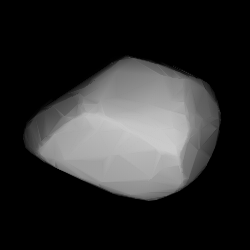 3D convex shape model of 186 Celuta | |
| Discovery | |
|---|---|
| Discovered by | P. M. Henry, 1878 |
| Discovery date | 6 April 1878 |
| Designations | |
| (186) Celuta | |
| Pronunciation | /sɛˈluːtə/ |
| A878 GA; 1954 FD | |
| Main belt | |
| Orbital characteristics[1] | |
| Epoch 31 July 2016 (JD 2457600.5) | |
| Uncertainty parameter 0 | |
| Observation arc | 132.36 yr (48343 d) |
| Aphelion | 2.7152 AU (406.19 Gm) |
| Perihelion | 2.0084 AU (300.45 Gm) |
| 2.3618 AU (353.32 Gm) | |
| Eccentricity | 0.14964 |
| 3.63 yr (1325.8 d) | |
| 275.22° | |
| 0° 16m 17.544s / day | |
| Inclination | 13.185° |
| 14.769° | |
| 315.65° | |
| Earth MOID | 1.01999 AU (152.588 Gm) |
| Jupiter MOID | 2.71546 AU (406.227 Gm) |
| TJupiter | 3.500 |
| Physical characteristics | |
| Dimensions | 49.99±1.6 km |
| 19.842 h (0.8268 d)[1][2] | |
| 0.1929±0.013 | |
| SK | |
| 8.91 | |
186 Celuta is a 50 km Main belt asteroid. It was discovered by the French astronomers Paul Henry and Prosper Henry on April 6, 1878. This was the last discovery credited to the Prosper brothers. It is classified as an S-type asteroid.
The asteroid is named after Céluta, a female character in two works of fiction by François-René de Chateaubriand, Atala (1801) and René (1802). The Henry brothers had already named another of their discoveries, 152 Atala, after the heroine of Atala.[3] Both Atala and Céluta are American Indian fictional characters.[4]
Photometric observations of this asteroid at the Organ Mesa Observatory in Las Cruces, New Mexico during 2010 gave a light curve with a period of 19.842 ± 0.001 hours and a brightness variation of 0.54 ± 0.02 in magnitude.[2]
- ^ a b Cite error: The named reference
JPLwas invoked but never defined (see the help page). - ^ a b Cite error: The named reference
Pilcher2011was invoked but never defined (see the help page). - ^ Schmadel, Lutz D.; International Astronomical Union (2012). Dictionary of minor planet names (6th ed.). Berlin; New York: Springer-Verlag. p. 29. ISBN 9783642297182. Retrieved 4 April 2014.
- ^ Chateaubriand, François-René (1801). Atala.; Chateaubriand, François-René (1802). René.